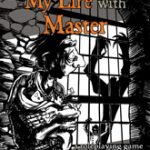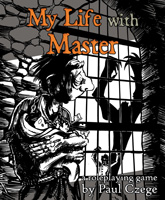My Life with Master: The Architecture of Protagonism

Paul Czege explains that he aimed for My Life with Master to be an engine for story creation rather than just another variation on the traditional role-playing game system.
My Life with Master is a role-playing game about the horrific and dysfunctional ties that bind a monstrous Master and his or her minions. Its mechanical core was designed over several mornings in the summer of 2002 - but it was a decade of dissatisfaction with published role-playing games, and then a year of experimental play, which made that possible.
The Dissatisfaction
Telling stories about your experiences is a process of selecting, organizing, and presenting a relevant subset of the superset of all possible information you could include in the story. And the organizing principle is your purpose for telling the story, the message you want to convey to the audience; you organize and present your information around that theme. As such, storytelling is a retroactive process. And traditional RPGs are storytelling like that. Their focus is on architecting events for throwing at the player characters. Story only happens in retrospect, when you pick from all the details of the game session and organize them for yourself in service to theme, character protagonism, and the dramatic. But when you’re in it, generating the non-thematic noise, and your interest is story, you’re not having much fun.
And so, ten years of clueless dissatisfaction, of not recognizing that a character needs the efforts of an active author if his emergence from noise as the protagonist of a story is to be anything other than retroactive construction (or railroading on the part of the gamemaster, which is actually a form of active authorship - just a socially dishonest one).
The Education
It was online conversations with Ron Edwards and others in 2000 that introduced me to Ron’s ideas about why people play, and how traditional game mechanics can disappoint or actively frustrate those priorities. I credit Ron for a dramatic renewal of my appreciation for the role-playing hobby. I began to play, widely, regularly, and experimentally, mostly free and self-published games. And from this I began to understand how powerful role-playing experiences that produce story with less noise could be delivered by game rules that consciously mediate play as an endeavor of collaborative authorship.
The Architecture of Protagonism
Traditional role-playing games fail consistently as engines of story creation from their relentless doubting of the protagonism of the player characters. A character can generally suffer an ignominious demise at any turn. No author of fiction would be so cavalier. And so neither is My Life with Master. Antagonism in traditional games is merely a continuous questioning of the survival and thematic credibility of the player character. No author of fiction would be so self-defeating of his storytelling effort. And so neither is My Life with Master.
The protagonism of the player character minion in My Life with Master is presumed, not earned. This presumption of protagonism is partly mechanical, in that game events threaten the fate of the character, but don’t impose that fate until the game’s denouement. And it is partly social, in that setup for play consists of a structure for conversation that collaboratively creates an antagonist (the Master), who all participants can love to hate, as well as a player character workshop that produces minions who thematically benefit from this antagonism. So, My Life with Master’s formula for play is simply a social and mechanical structure in which the other players are an interested audience to the struggles of a given player character, because they have creative investment in the character and the antagonist, and the game rules can be trusted to not disappoint that interest.
Works Cited
My Life with Master. Paul Czege; Half Meme Press. 2003.
Cite this essay
Czege, Paul. "My Life with Master: The Architecture of Protagonism" Electronic Book Review, 13 October 2007, https://electronicbookreview.com/publications/my-life-with-master-the-architecture-of-protagonism/
